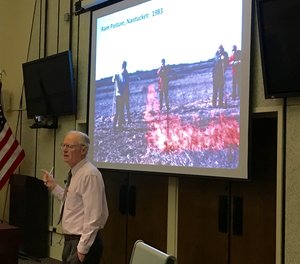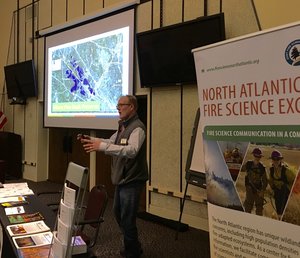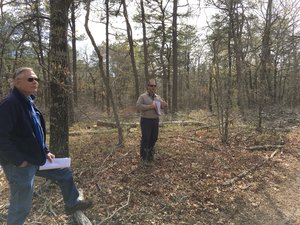Long Island Workshop Recap: Keeping the pine in the pine barrens
- Inga La Puma and Kathy Schwager
- Jul 25, 2017
- 4 min read
Updated: Dec 14, 2020
Photos by Inga La Puma
It was a rainy day for travel, but as speakers and participants from the region gathered on a Wednesday night in early May for an evening discussion with fire managers, it quickly became obvious that we were in for a treat. As a New Jersey wildland fire scientist, the Long Island pines had always intrigued me, and I was sincerely excited to finally see the area. It just seemed so weird to me that there would be a coastal plains pitch pine community ON LONG ISLAND. Just as Before I moved to NJ, I pictured it as an industrial area (it mostly isn’t). Similarly, I had pictured Long Island as mostly developed; but here we were at Brookhaven National Lab surrounded by forest! It was quite a pleasant surprise. The main difference I noticed right away was that the trees here seemed smaller and closer together than our pinelands in NJ, at least near the highways.
The agenda began with an evening discussion panel which included Tim Kelly, Deputy Fire Chief at Brookhaven National Laboratory who is responsible for 5000 acres on the site with only 6 firefighters to assist him. Also present were Tom Gerber, Section Warden, NJ Forest Fire Service, who conducted prescribed fires on up to 5000 acres this year in the NJ pinelands as well as Alex Entrup, Senior Specialist, Northeast Forest & Fire Management, LLC, who used to burn with The Nature Conservancy on Long Island. Finally, Brian Gallagher, a NY state forest ranger for 18 years who is attempting to bring prescribed fire back to the island’s forests.
There was an in-depth discussion of equipment and tactics for fighting fire in the pinelands effectively. I was fascinated by the stories of evolving communications between local fire departments and state and federal partners. The most recent fire on Brookhaven lands benefited greatly from an improved command structure compared to previous large fires. One of the more salient points that was made was this: the time to talk about health and safety of firefighters and the community is not DURING a fire, but now, when fire management plans and fuel reduction actions can be most effective. A local fire department chief noted that local fire chiefs do seem interested in gaining operational training for wildland fire since the Sunrise fire of 1995 and Brookhaven fire of 2012, but that these volunteer departments are already strapped for time and money. Having prescribed fire trainings on the weekends would help.
The next morning we were treated to several presentations designed to give context to wild and prescribed fire efforts in Long Island. Bill Patterson, Neil Gifford, and Tim Simmons provided the first set of talks and the morning panel, offering outside perspectives of the issues facing other pine barrens ecosystems in the Northeast in comparison to Long Island, including seasonality, habitat restoration, and dealing with the wildland-urban interface.
The Long Island pine barrens are under increasing attack by the southern pine beetle. We heard from Jack Nowak, a southern pine beetle and fire expert from Asheville who stressed the importance of spacing between pines and the role of prescribed fire. Ken Clark who studies the effects of southern pine beetle in the New Jersey Pinelands also spoke. Then all of the speakers got together at the front of the room along with locals John Pavacic, Executive Director of the Long Island Pine Barrens Commission, and John Werner, of NY State Department of Conservation to answer questions and continue the discussion.
Kathy Schwager, Brookhaven ecologist and Community Representative for NAFSE, started out the afternoon field trip with stops at local burn units as well as the 2012 Crescent Bow fire. She and her team are monitoring fuels after fire as well as infestations of orange-striped oak worm and gypsy moth attacks from the early 2000’s. We visited one unit in particular where basal area had decreased to 70 ft. squared per acre, but live fuel loading had increased by over 400% due to the opening of the canopy. (Kathy and crew were able to burn this unit last month). Kathy also discussed the mesophication that they are documenting through their forest health monitoring.
Next, we visited the New York State Department of Environmental Conservation’s Rocky Point Demonstration Forest adjacent to several communities and values at risk, where they are thinning, burning, or thinning and burning several plots. The management plan for these plots includes continued monitoring to determine the effects of reducing basal area and removing fuels to benefit forest health and prevent southern pine beetle invasion.
As a result of this workshop, increased coordination and communication has evolved in the area. Cooperators have burned almost 200 acres of grassland in the pine barrens this spring and have started conducting growing season burns in woodlands at Brookhaven Lab. These are the first woodland burns conducted on Long Island since 2008. The workshop was another example of how discussing research, visiting sites and promoting face to face social issues works! Finally getting to the Long Island pine barrens was everything I had hoped for, but my increased understanding of local research and communication was the real treat.











